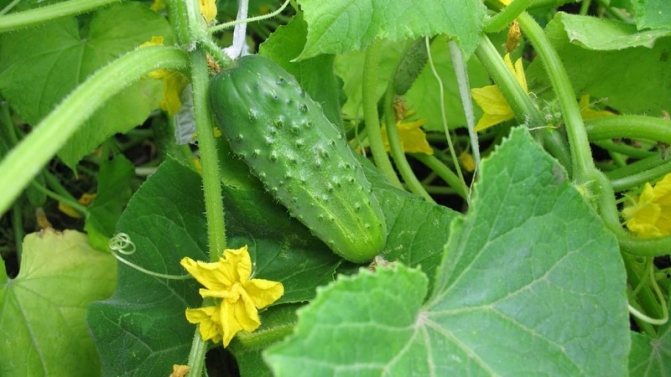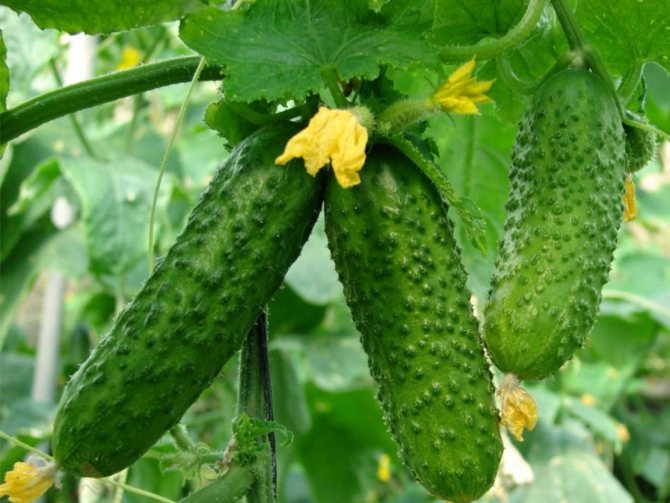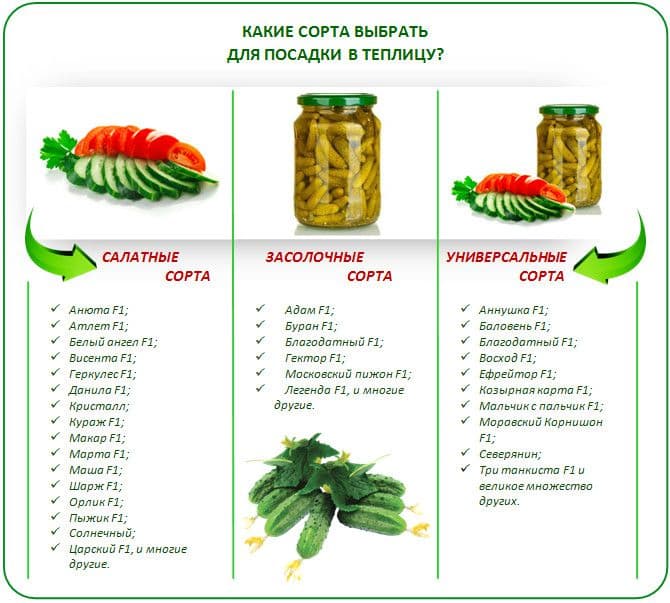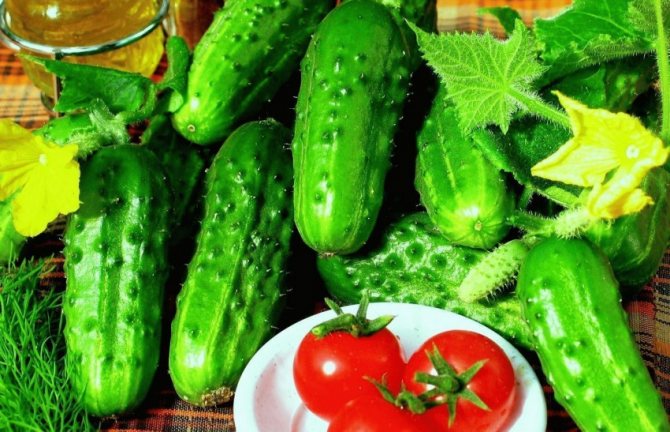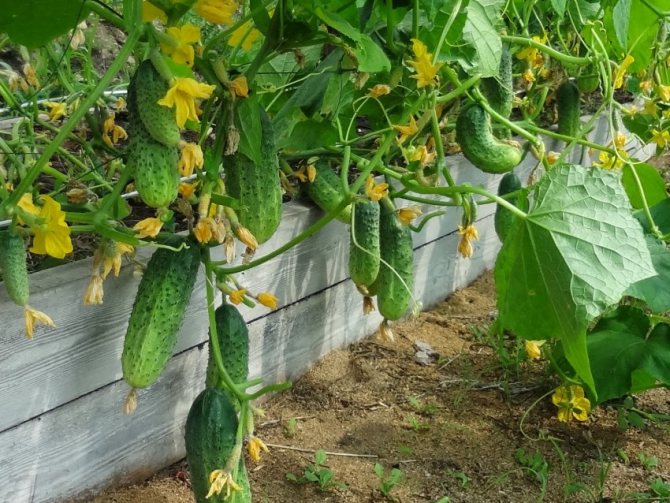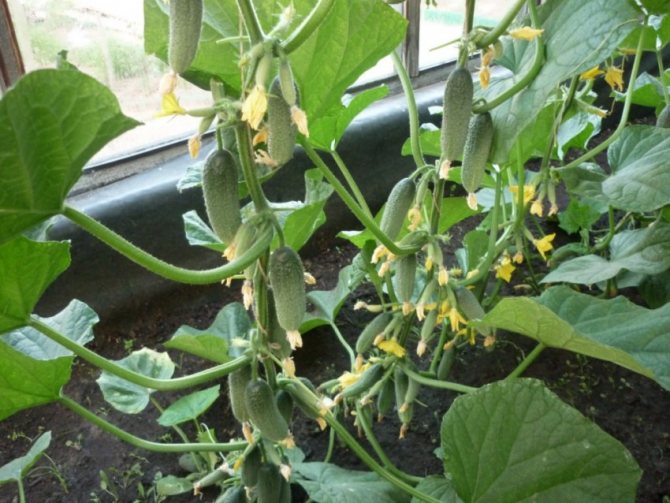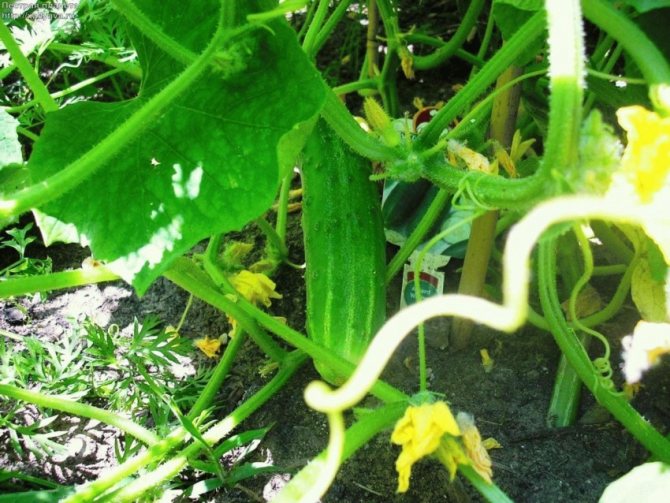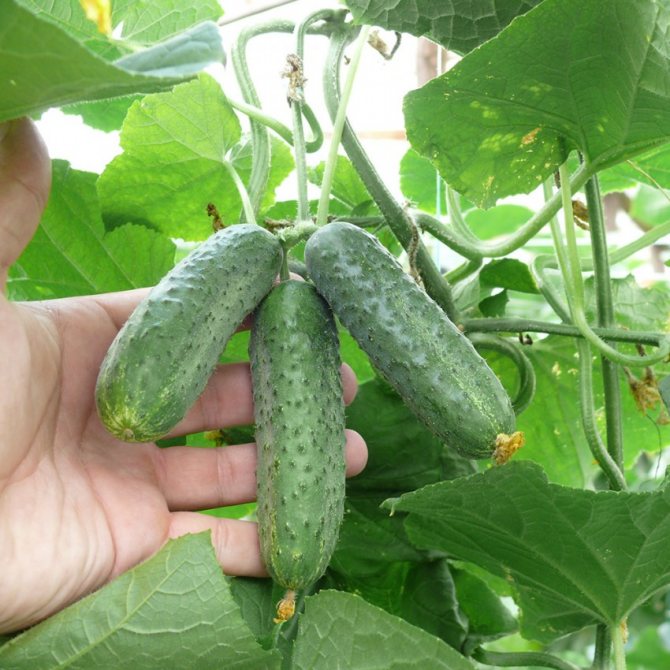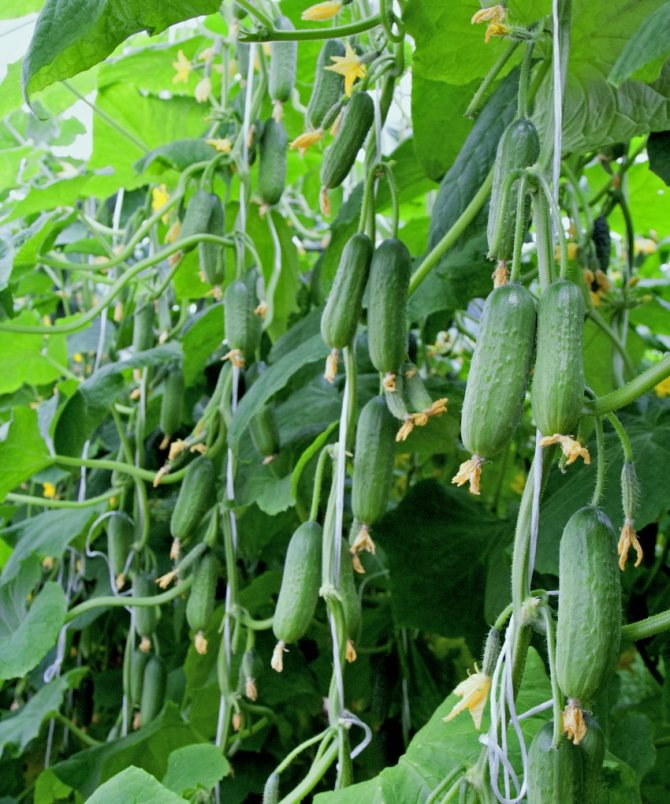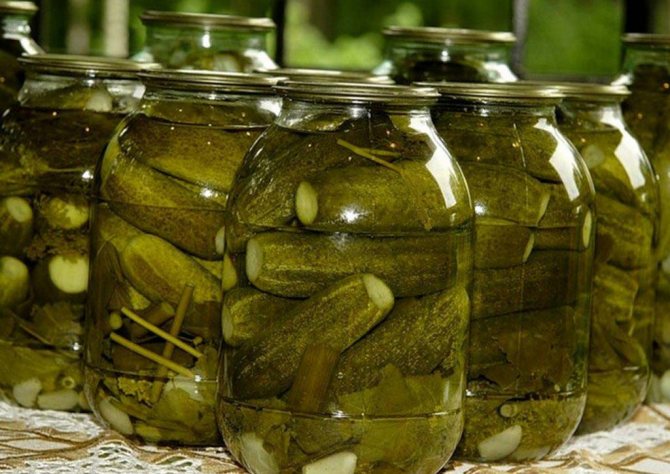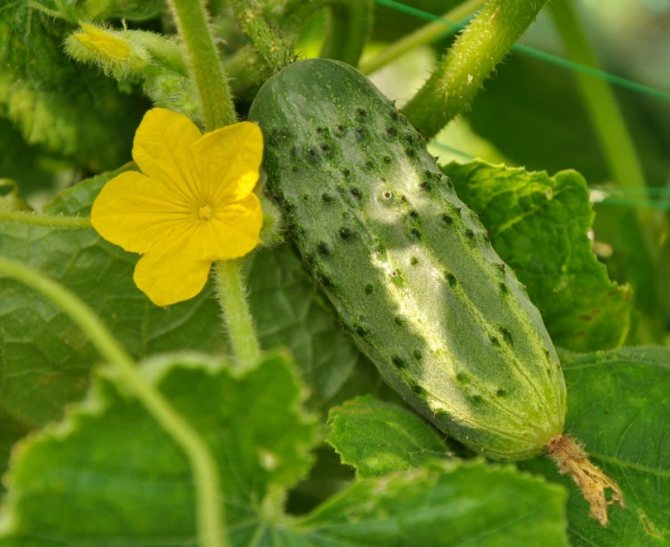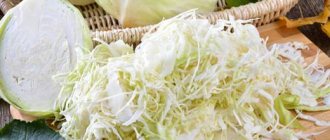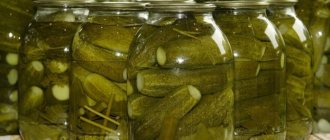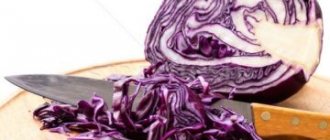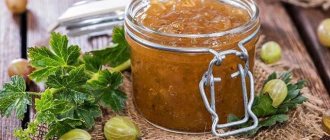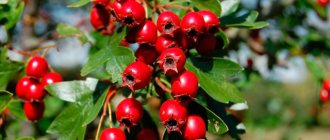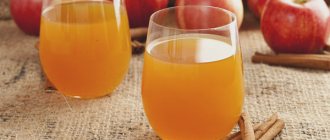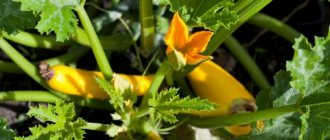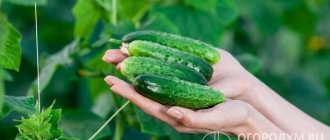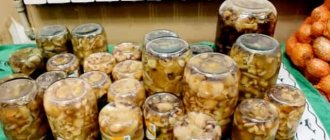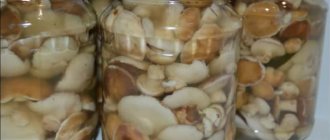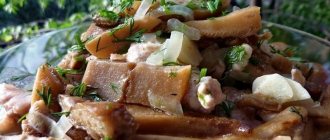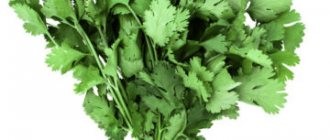Each owner of a backyard farm or plot of land plans in advance: what kind of vegetables and fruits he will grow; which of them will be consumed fresh, and which will be used for homemade preparations. Experienced housewives know that the key to success in winter procurement is not only strict adherence to the recipe, but also the quality of raw materials. At first glance, all cucumbers are similar, but this impression is deceiving, because the varieties of this vegetable are divided into salad (intended for fresh consumption) and those intended for pickling and canning. If you are planning to preserve cucumbers for the winter, it is better to immediately plant suitable varieties in the garden.
The article gives useful advice on how to select the most suitable varieties of cucumbers for canning based on their appearance, and also talks about modern and classic varieties suitable for pickling. Home garden lovers will also be able to find useful information for themselves on the correct choice of cucumber seeds for planting them for conservation. In this article, you will also find useful information on the selection of cucumbers for canning, as well as photos and descriptions of the best varieties. In addition, here are some simple but field-proven recipes to help keep your vegetables tasty and crispy throughout the winter.
- Cold salting
Which cucumbers are suitable for winter storage?
For harvesting for the winter, both greenhouse varieties and cucumbers grown in the open field are suitable. Although experienced housewives prefer the latter option, since such vegetables are more aromatic and tasty.
The main features of good pickling cucumbers include the following criteria:
- a small amount of seeds in the fruit;
- the presence of black thorns and a lumpy surface of the peel;
- the size of the vegetable does not exceed 15 cm;
- the skin of the vegetable has a rich green color, which is not lost when salting;
- crispy flesh, no voids inside the cucumber.
How to choose the right cucumbers for pickling
Species intended specifically for canning have a list of certain differences.
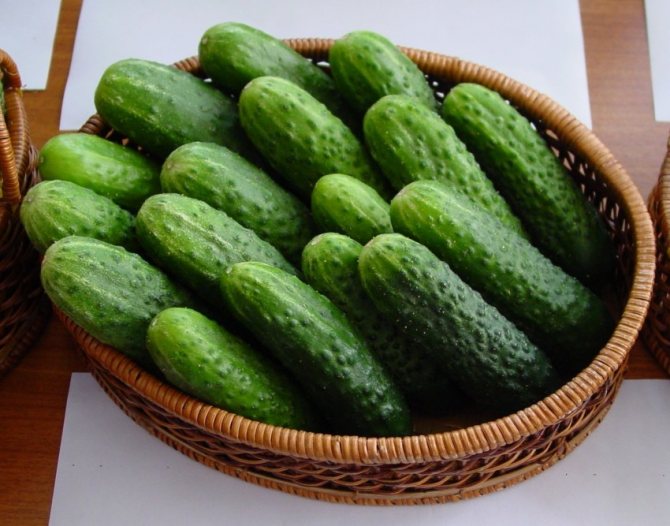
First is the peel. It is covered with distinct tubercles and small, but rather sharp spines with a white tip. Upon reaching full maturity, the thorns are easily removed.
The second difference is the pulp. It is denser and more crunchy than regular cucumbers, with fewer seeds and no wasteland.
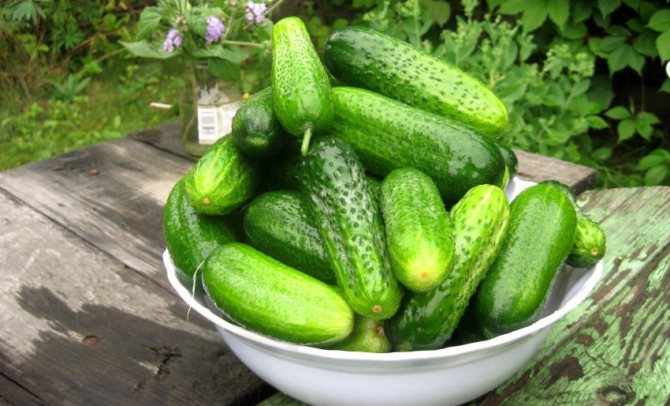

Also, when choosing seeds of the pickling type, do not forget to pay attention to their packaging. Their intended use must be written on it.
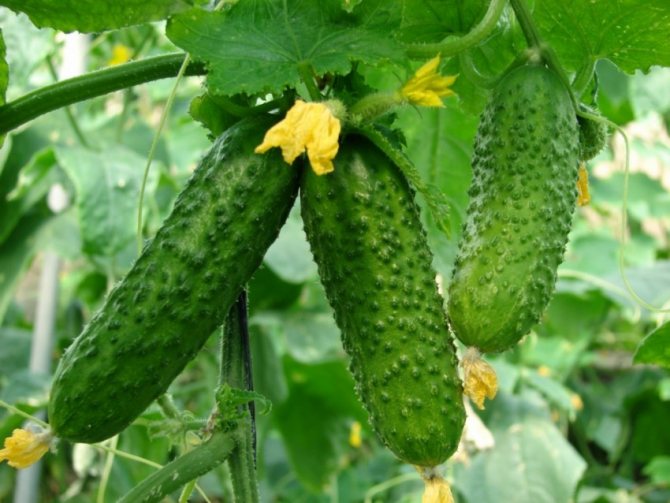

Which ones don't fit?
For canning for the winter, you should avoid vegetables with the following signs:
- overripe, large cucumbers;
- vegetables from supermarkets;
- gnarled cucumbers of irregular shape;
- fruits with white pimples;
- thin-skinned vegetables;
- grafted fruits with a yellowish bloom;
- washed cucumbers.
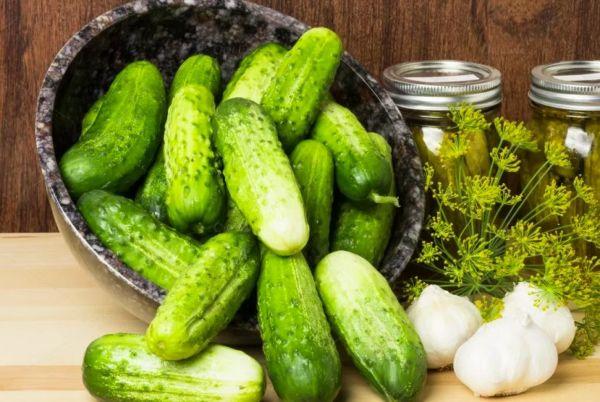

Water for pickling cucumbers
Of course, water quality is a very important factor. It is better to use hard water such as spring water. It contains calcium salts. If you are using tap water, then you need to at least defend it in order to reduce the chlorine content.Soft water is also not suitable for salting. Do not use iodized or fluorinated salt for pickling.
You can artificially improve soft water. The experience of the Ukrainian Research Institute of Vegetable and Melon Growing has proven that the addition of calcium chloride (it is sold in ampoules in pharmacies) to the water improves the quality of salted products. Calcium chloride is added to the brine - 5-7 drops per three-liter jar.
The best varieties of cucumbers for pickling and canning
Among the existing varieties of cucumbers, it is difficult to choose those suitable for pickling. Even experienced gardeners cannot do this. It is necessary to be able to correctly select seeds for sowing and suitable soil, as well as externally distinguish between fruits that are best suited for canning.
Is it possible to salt and pickle
It is worth considering in more detail the varieties of cucumbers in order to determine which of them are perfect for pickling, and which are not recommended to use.
Greenhouse and greenhouse cucumbers
Greenhouse cucumbers are less commonly used for pickling for the winter than those grown in the open field. And yet, this category has its own favorites, which are preferred by experienced housewives.
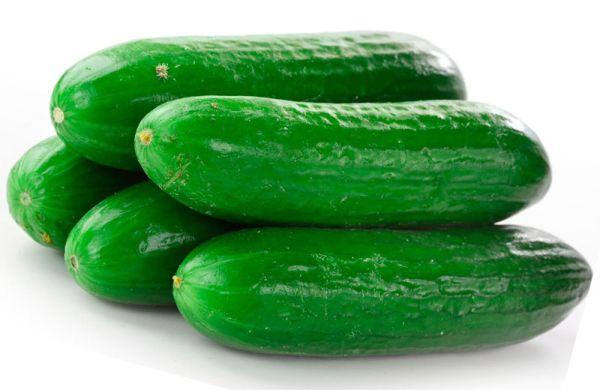

The list of pickled vegetables includes the following varieties:
- Marfinsky;
- Pallas' cat;
- Home;
- Relay race;
- Solar;
- Martha.
This is not a complete list of pickling varieties grown in greenhouses and hotbeds.
April cucumbers
You can determine if a cucumber is suitable for pickling by its description. April F1 belongs to the category of hybrid varieties. This is a parthenocarpic self-pollinated vegetable that is successfully grown by summer residents both in open and closed ground. They do not exceed 25 cm in size and have a lumpy surface. According to gardeners, this hybrid is great for pickling and pickling. In addition, it ripens amicably, which makes it possible not to stretch the seaming process for a long period.
See also
Recipes for pickling cucumbers with oak leaves for the winter in jars
To read
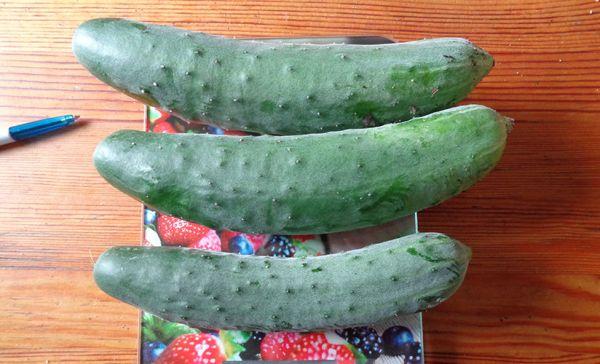

Lukhovitsky
Lukhovitsky cucumbers have been cultivated by the inhabitants of this city for a long time and are the best suited for pickling for the winter. The soil and climatic conditions of this city near Moscow make it possible to harvest a crop with an appetizing crunch, thin skin and pulp without voids.
They ripen early, are not afraid of diseases affecting this culture, and are resistant to cold weather. They are suitable both for fresh consumption and for preparations for the winter.
Smooth
Covering smooth-skinned cucumbers for the winter is not recommended. In the marinade, they become tasteless, spread out in a jar, and you can't wait for an appetizing crunch from such vegetables. It is better to use such fruits for fresh consumption.
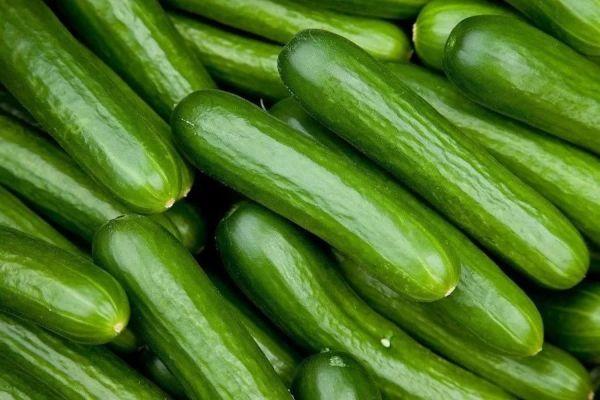

Yellow cucumbers
As a rule, yellow cucumbers are not used for pickling, they are used for salad. To do this, peel them from them and cut out the core with coarse seeds.
Barrel Snack F1 for pickling
This variety belongs to ultra-early maturing, parthenocarpic. Harvesting takes place on day 40-45. The plant has medium branching. They are shaped like a cylinder, 8-9 cm long. Small tubercles are present on the surface. Excellent taste, no bitterness. You can grow it in an open area or in a greenhouse. Fresh cucumbers are used, as well as for pickling.
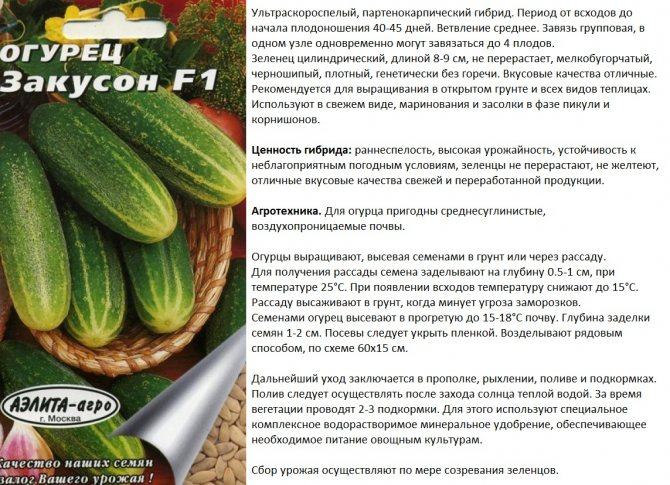

This variety is appreciated for its early ripening period, high yield and resistance to negative weather influences. I do not outgrow, yellowness does not appear on their surface.
Which early self-pollinated varieties for open ground are most often used is indicated in this article.
The best varieties for pickling
For harvesting for the winter, there are a huge number of varieties of cucumbers. They get acquainted with their name before purchasing seeds and study the description of the variety or hybrid.
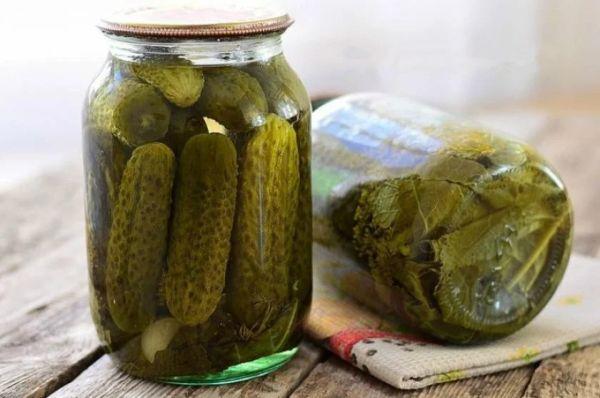

Greenhouse
You can also roll up greenhouse cucumbers, but it is important to choose the right variety. The list of the best representatives includes the following:
- Salting. The fruits of this variety do not grow more than 11 cm, which is very convenient for canning in liter jars. There are small thorns and light stripes along the entire surface of the vegetable. The shape of the greenery is slightly round. The advantage of this variety is that it is resistant to most crop diseases.
- Nezhinsky 12. The variety has good yields and is popular with gardeners. Small oval greens crunch perfectly in salting, not watery and have a pleasant taste. Small black dots cover the entire surface of the vegetable.
- Zozulya F1. A hybrid that is suitable for indoor and outdoor use. A plus is the absence of the need for pollination by bees. An oblong and even vegetable begins to be harvested on the 40th day from the moment of disembarkation. Demonstrates high yield rates.
- Goosebump F1. Another hybrid suitable for both pickling and canning. Resistant to temperature extremes and common diseases. The crispy structure and bright pleasant taste make it one of the leaders among summer residents.
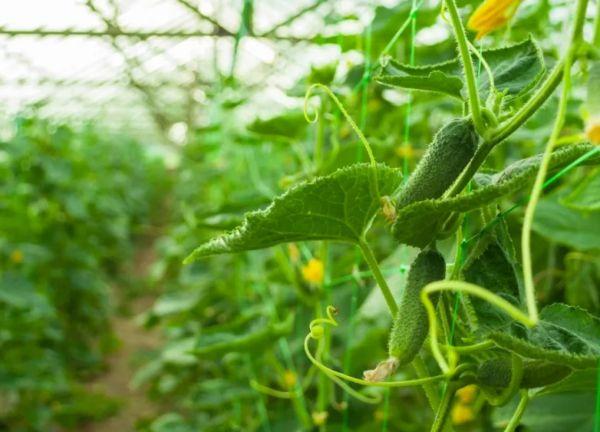

For open ground
The choice of varieties for open ground is much wider. Among the favorites are such varieties:
- Mother-in-law F1. Black-thorn and medium-lumpy fruits grow up to 10-12 cm. The vegetable is not afraid of sudden cold snaps and temperature changes. The main thing is to pick the cucumbers on time, as they tend to overgrow.
- Boy with thumb F1. A hybrid belonging to the category of gherkins and ideal for pickling in the winter. The homogeneous and void-free pulp is not bitter and has small seeds. A vegetable grows on average to 8-10 cm.
- Darkie F1. The fruits have black thorns and are 10-12 cm in size. The pulp is without bitterness, tasty and crunchy.
See also
Recipes of pickled cucumbers in their own juice for the winter "lick your fingers" without sterilization
To read
Pickling varieties of cucumbers for open ground
According to the ripening time, early, mid-season and late varieties of cucumbers for open ground are distinguished. To get a good harvest, you need to take into account not only the manufacturer's recommendations, but also the composition of the soil, opportunities for care. In regions with a stable climate, the best varieties of pickled cucumbers can be grown outdoors.
Nezhinsky
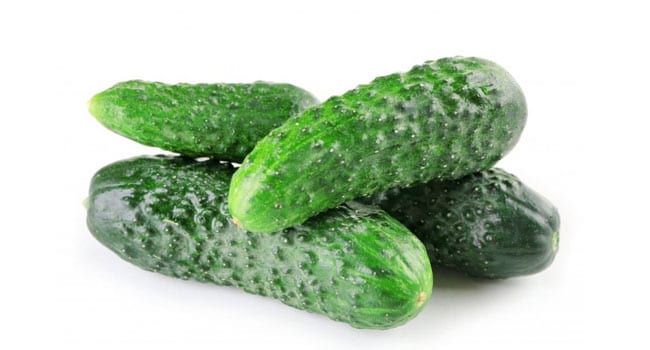

Cucumber Nezhinsky
Pickled cucumber Nezhinsky can grow in open ground and in a greenhouse. The variety is resistant to diseases, bee-pollinated. Characteristics:
- medium late, technical ripeness occurs in 47–55 days;
- average yield, about 2 kg per 1 sq. m;
- the size of the greenery is 10 cm, the peel is large tuberous, dark green in color;
- thorns are black;
- weight - 80-110 g;
- keeping quality is low, cucumbers lose their presentation within 5-7 days;
- pronounced aroma and traditional taste.
Cucumber Murom
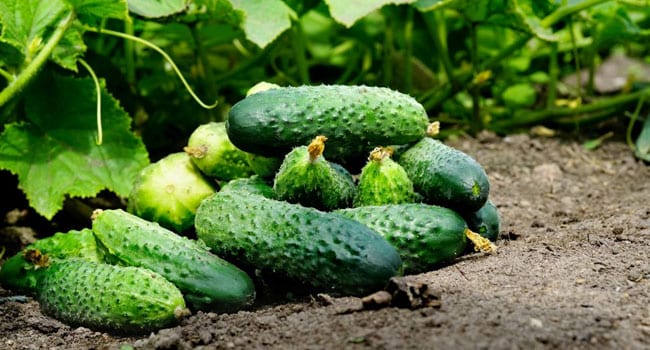

Murom cucumber variety
Bee-pollinated variety. The bushes grow with short branches and have a significant green mass. Varietal material is resistant to temperature drop, pimply fruits have a pronounced aroma and excellent taste without bitterness, which is important for salting. Murom cucumber is characterized by the following features:
- ultra early ripening, technical ripeness occurs 35 days after germination;
- yield - up to 3 kg per 1 sq. m;
- the size of the fruits is about 8 cm, the peel is light green, with whitish stripes, ribbing is present;
- spines are black, small;
- weight - 50–70 g;
- keeping quality - about 5 days;
- the fruits have typical cucumber flavor and aroma.
Emerald Stream F1
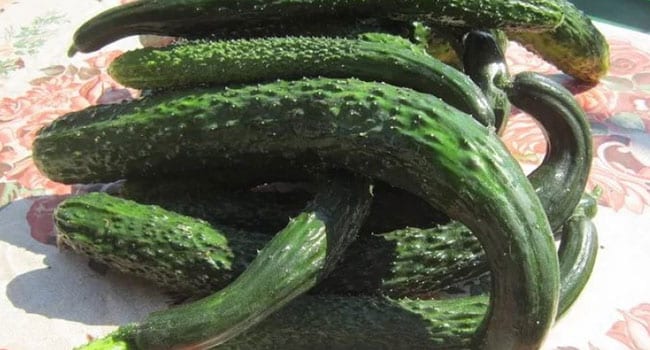

Variety Emerald Stream F1
This hybrid was bred by Moscow breeders in 2007. Cucumbers have a very specific look. The vegetable can be grown in greenhouse and soil conditions. The species is shade-loving and does not require artificial pollination. Because of their size, cucumbers are not suitable for pickling as a whole. Characteristics:
- mid-season, ready for use on the 50th day after germination;
- high yield - about 5 kg of harvest can be obtained from one square;
- fruits are long - up to 50 cm, the peel is dark green, high-tuberous;
- the thorns are small, whitish;
- average weight - 150 g;
- keeping quality - about 10 days;
- has a strong aroma and sweetish taste.
Barrel pickling
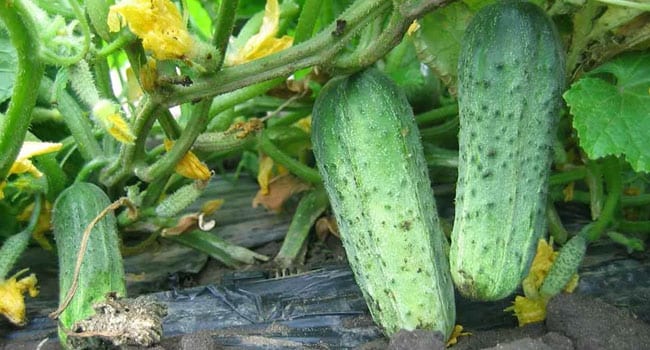

Barrel pickled cucumber
It is a high-yielding prickly variety of the gherkin type. It is resistant to diseases, bee-pollinated. Used for winter storage or seasonal salt. Differs in the following characteristics:
- medium early appearance, the period from germination to fruiting is 41–45 days;
- the yield is up to 4 kg per 1 sq. m;
- fruit size - 9–11 cm, dark green skin, medium density;
- the thorns are white, with a dark edge;
- weight is 80–95 g;
- keeping quality - 5-7 days, long-term storage is not provided;
- the taste is neutral, there is no bitterness.
Zozulya F1
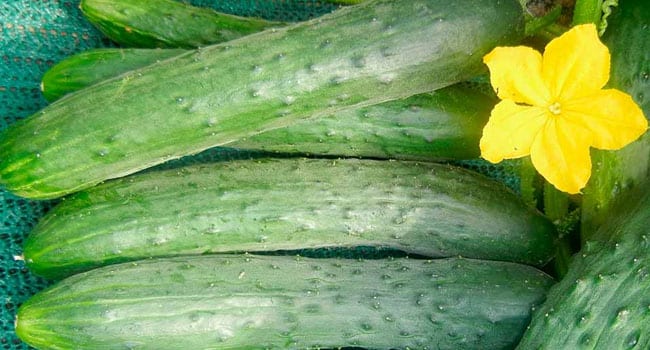

Zozulya F1
The self-pollinated long-leafed hybrid is resistant to many viruses. This indeterminate plant tolerates moderate shade well. Excessive moisture can have a detrimental effect on yields. Signs:
- early ripening variety (receiving the first fruits in 35–40 days);
- yield - up to 20 kg per 1 sq. m;
- fruit size - 16-22 cm, the skin is dark green, medium lumpy, with whitish stripes;
- white-thorn;
- the average mass of greens is 300 g;
- keeping quality - up to 14 days;
- classic cucumber taste and fresh aroma.
Rules for picking cucumbers for conservation
For a crispy and tasty product, it is important to pick the cucumbers correctly for canning. This is done either in the early morning or in the evening when the sun begins to set. Vegetables are carefully separated from the lashes, being careful not to damage the bush. If there is a long transportation ahead, the flowers at the ends of the cucumbers are not removed, so they will be better preserved.
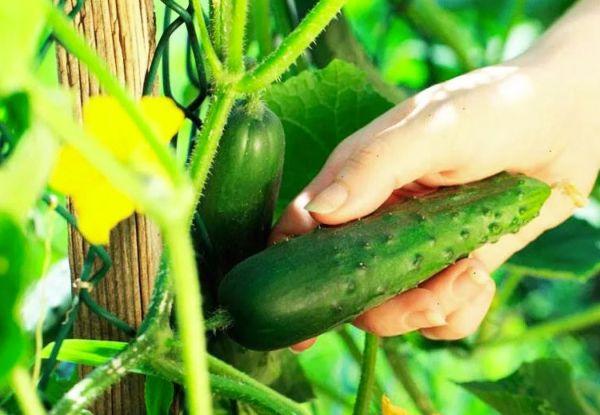

Agrotechnics of growing cucumbers for pickling
The quality of pickling cucumbers depends on the cultivation technology. With rare watering, a void often appears inside the fruit, they can taste bitter. At the same time, the quality of the crop is significantly reduced.
For cucumbers grown with regular, even watering, the quality of the fruit is much higher. It is very important to maintain the humidity of air and soil within 80%. In hot weather, refreshing watering is useful. Try not to pour water at the root. Firstly, with such watering, the roots are exposed, and secondly, the plants can get sick with root rot.
Cucumbers don't like cold water. Warm water (not lower than 20-22 degrees) from a barrel in the sun is what you need for this thermophilic vegetable.
Cucumber culture has a peculiarity: the yield will be the higher, the more often they are cut off. When collecting, try not to turn the cucumber lashes - they are very fragile, they can easily break, moreover, an infection gets into the wounds, cracks.
It is best to pick the cucumbers in the morning before they get hot. And with frequent watering, you need to feed more often. The root system of cucumbers is characterized by a low removal of nutrients from the soil, but a high intensity of their consumption.
Cucumber plants do not withstand high concentrations of soil solution, and they should be fed in small doses every 10-12 days. Salted varieties, as well as salad varieties, respond well to organic feeding: mullein solution (1: 5), chicken droppings (1:10). It will not be superfluous to add an ash solution to these solutions - 1 glass of ash (100-150 g) per bucket.
The best recipes
From the piggy bank of the best recipes, each housewife will choose the option she likes.
Cold salting
Ingredient composition:
- 2 kg of zelents;
- 5-6 cloves of garlic;
- 2 tbsp. spoons of coarse rock salt;
- 1 tbsp. a spoonful of granulated sugar;
- 2 pcs. horseradish leaves;
- 3 umbrellas of dill and parsley;
- half hot pepper.
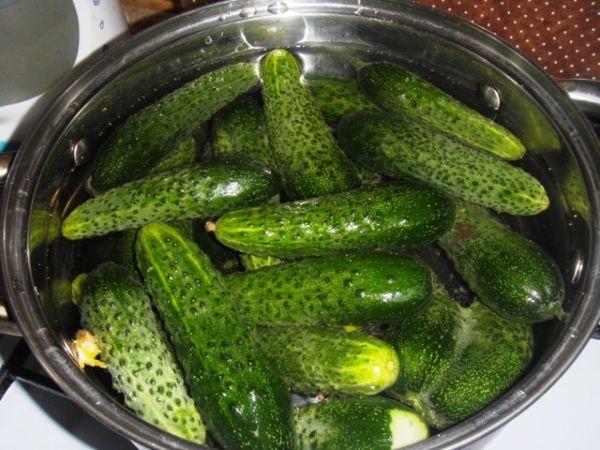

Place the washed vegetables in a deep saucepan and cover with an inverted plate. Pour cold water and let stand for 2 hours. 1200 ml of water is poured into another container, salt and sugar are added and set to boil.After the brine has cooled down a little, put it in the refrigerator for 2 hours.
Cucumbers are placed in a sterile container, sprinkled with seasonings and herbs. Pour cold marinade, cover with gauze and let stand for 5 hours. Then they are closed with ordinary lids and taken out into the cellar.
Hot salting
Prepare as components:
- 3.5 kg of fresh greens;
- 200 grams of coarse salt and 3 teaspoons of granulated sugar;
- a few cloves of garlic;
- oak leaves, cherries, currants and dill umbrellas.
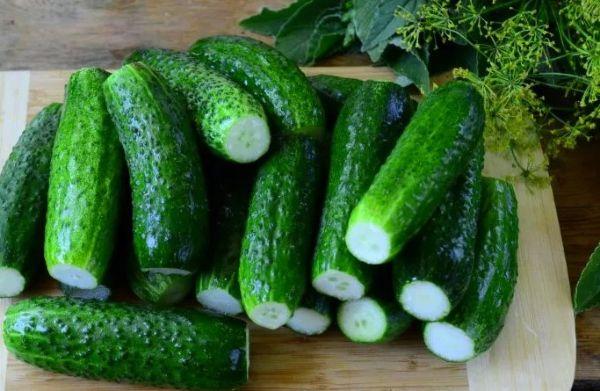

The tails and noses of cucumbers are cut off and placed in clean jars. Garlic and aromatic spices are also sent there. The specified amount of salt and sugar is dissolved in three liters of water, boiled and jars of vegetables are poured with marinade. They are put on sterilization and rolled up with metal lids.
Salting and canning hybrids
In Russia, you can also grow various hybrids that are great for conservation and salting.
Magnificent F1
Medium early bee-pollinated hybrid grown outdoors. Elongated fruits reach 10-12 cm in length and gain weight about 120 g. On the 50th day after the seeds have sprouted, you can look for ripe fruits on the bushes.
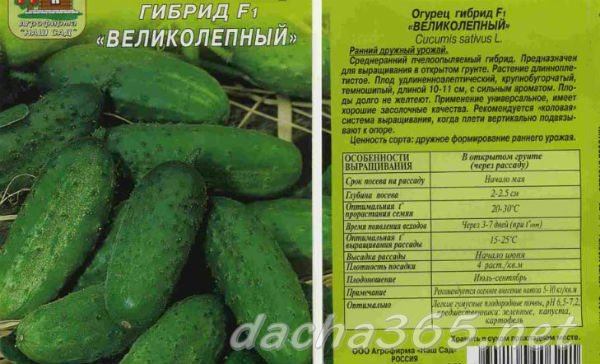

Lilliput F1
With proper agricultural technology, ripe fruits are harvested from June 15th. Cucumbers reach 7-9 cm in length. Peel with small white thorns. Unpretentious care. 10-12 kg of vegetables are harvested from a square plot measuring 1x1 m. Afraid of temperature changes.
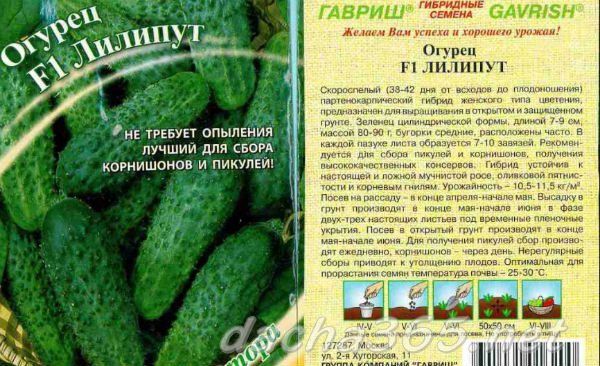

Goosebump F1
An early ripe self-pollinated hybrid. Elongated fruits of a dark green shade reach 15 cm in length, have many tubercles. 7 kg of vegetables are harvested from a square plot measuring 1x1 m. The pulp is crispy, without bitterness and voids.


Zyatek F1
Super early self-pollinated hybrid. On the 40th day after the sprouts have appeared from the seeds, you can look for ripe fruits on the bushes. Produces a good harvest in any cultivation conditions in any weather. Elongated fruits reach 12-14 cm in length, have many tubercles and soft thorns.


Fun guys F1
An early parthenocarpic hybrid. Not susceptible to cucumber mosaic, downy mildew and common powdery mildew. Cucumbers with small stripes on a green skin, there are tubercles. The pulp is crispy, without bitterness.
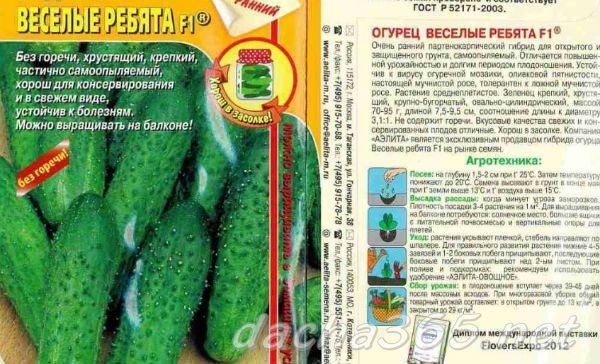

Table F1
A bee-pollinated hybrid for greenhouse cultivation. Elongated fruits are green with white stripes on the skin, reaching 12 cm in length and gaining weight of about 100 g. The pulp is dense, crunches, without bitterness. 20 kg of vegetables are harvested from a square plot measuring 1x1 m.
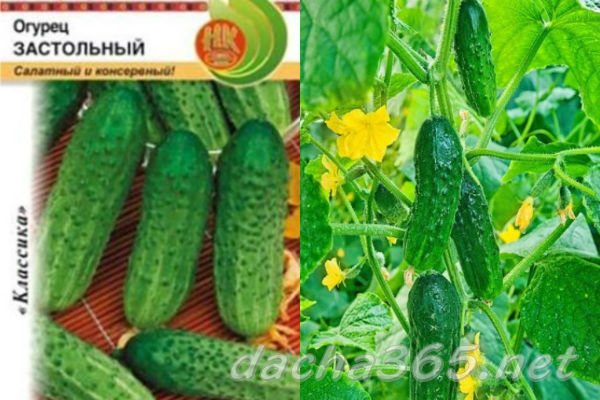

Siberian salting F1
New hybrid resistant to bad weather. Suitable for cultivation in areas of risky farming. Short fruits reach 6-8 cm in length. The pulp is dense, without bitterness. The skin is light with small tubercles and thorns.
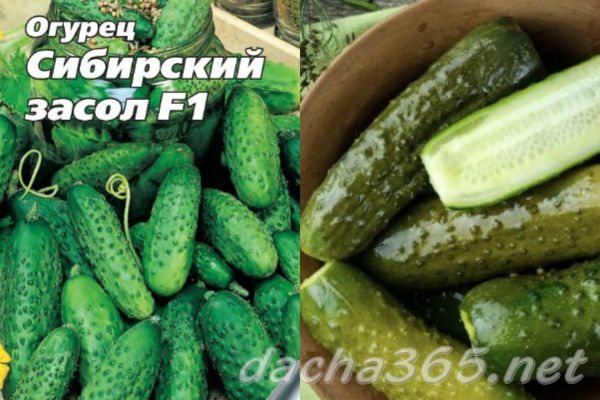

Maryina Roshcha F1
A bunchy hybrid of early ripening. Fruits are formed for a long time, ripening together on each bush for 10-12 pieces. Fruits reach 10-12 cm in length. The pulp is dense, without bitterness.
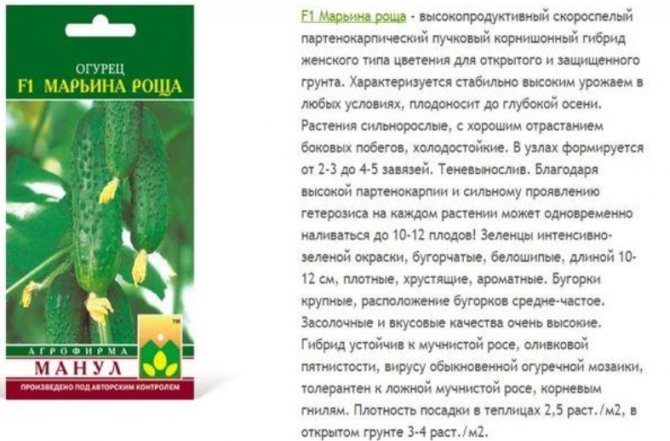

Hit of the season F1
Gherkin hybrid. Produces a rich harvest in all conditions. Fruiting until late autumn. In each node, 3-6 ovaries appear at once. Lateral shoots grow quickly. Fruits reach 8-11 cm in length, with white thorns.
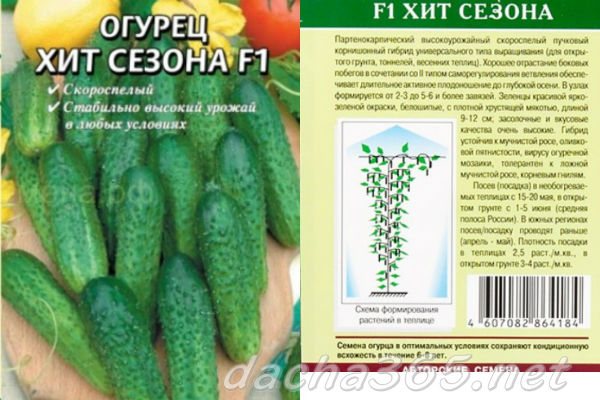

F1 white sugar
A hybrid with milky cucumbers, not whimsical to care for. On the 48-50th day after the sprouts have appeared from the seeds, you can look for ripe fruits on the bushes. Cucumbers reach 10-12 cm in length, skin with small tubercles. Suitable for cultivation in areas with harsh climates.
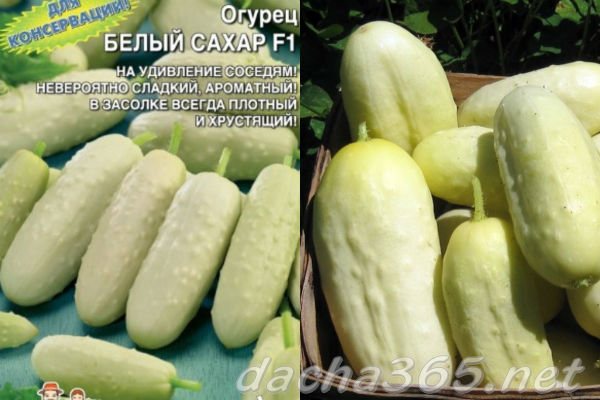

Of the hybrids, Russian gardeners also like to grow such hybrids as Ginga F1, Kroshka Raccoon F1. Among the gherkins, the best qualities are the Son of the F1 regiment, Ekol F1, Temp F1, Sankina love F1.
Dutch cucumber hybrids, bunch
Their distinctive features are that they have small fruits, medium-sized tubercles, with thorns, which are located more often than in Russian varieties. This type of peel is called a Dutch shirt.They have a bouquet flowering - sometimes up to 10 ovaries have one bunch, they bear fruit for a long time. Tufted cucumbers are good for pickling. Harvesting can begin no later than they reach a length of 5-7 cm. Experts advise adding as much seasoning as possible when pickling them. Overgrown fruits become tough, hard, tasteless. Cucumbers of this type include, for example, hybrids "Ekol F1", "Temp F1", "Herman F1", and others.

